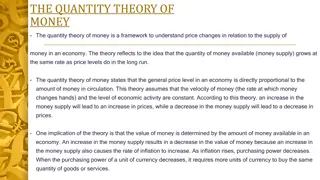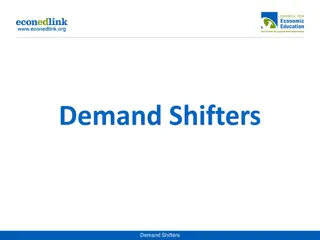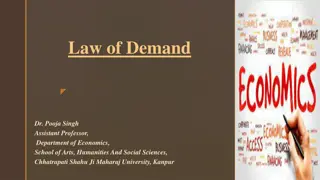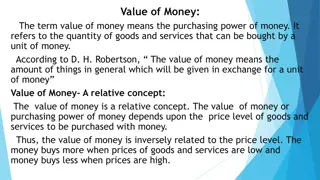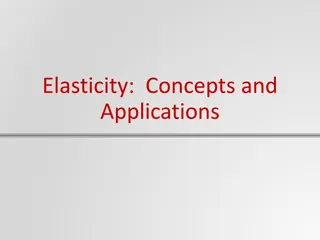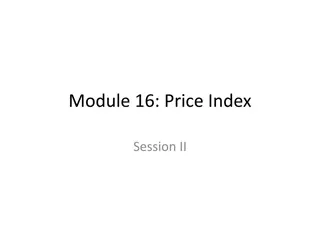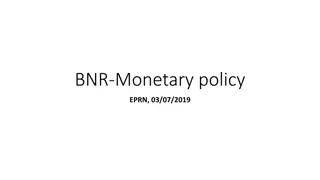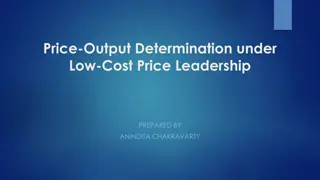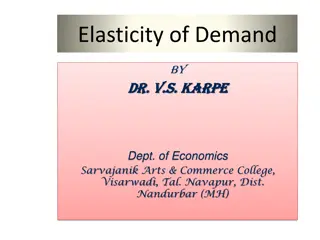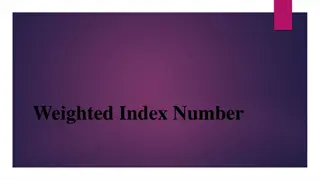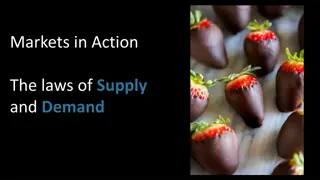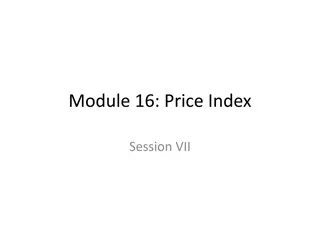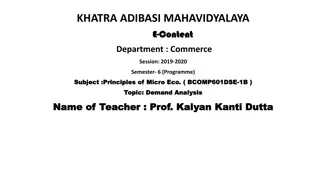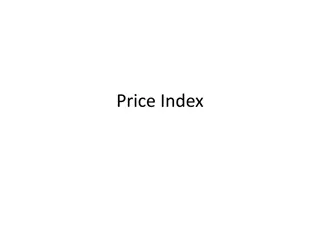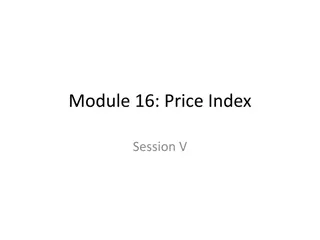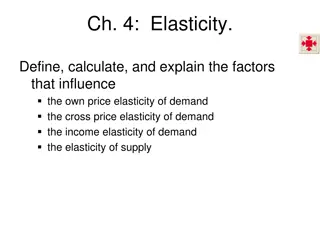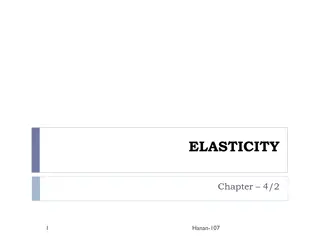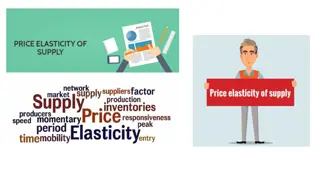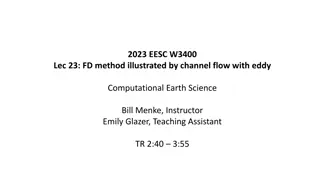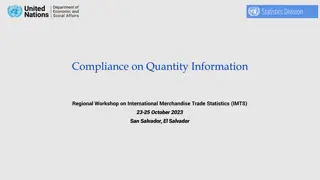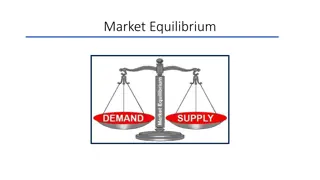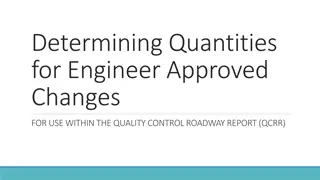Optimizing Minimum Order Quantity Strategies for Supply Chain Success
Welcome to our presentation on \"Minimum Order Quantity (MOQ): Optimizing Supply Chain Efficiency.\" In today's dynamic business environment, managing inventory effectively is crucial for businesses to minimize costs and maximize profitability. One key aspect of inventory management is determining t
7 views • 7 slides
Understanding the Quantity Theory of Money
The quantity theory of money posits a direct relationship between the supply of money in an economy and price levels, assuming a constant velocity of money and economic activity. Increases in the money supply lead to price inflation, devaluing currency and decreasing purchasing power. Two main versi
2 views • 6 slides
Understanding Scientific Purchasing Principles for Effective Procurement
Scientific Purchasing, also known as Procurement, involves buying materials efficiently by focusing on quality, quantity, price, place, and time considerations. This process ensures optimal stocking levels, timely procurement, and cost-effective sourcing to meet organizational needs. By adhering to
1 views • 13 slides
Understanding the Quantity Theory of Money: Fisher vs. Cambridge Perspectives
The Quantity Theory of Money explains the relationship between money supply and the general price level in an economy. Fisher's Equation of Exchange and the Cambridge Equation offer different perspectives on this theory, focusing on money supply vs. demand for money, different definitions of money,
0 views • 7 slides
Understanding Demand Shifters in Economics
Explore the concept of demand shifters in economics, including the factors that influence changes in demand such as consumer income, number of consumers, prices of substitute and complimentary goods, consumer preferences, and expectations. Learn how changes in these factors impact the quantity deman
0 views • 14 slides
Exploring the Impact of Salt Quantity on Saltwater Circuit Current
A saltwater circuit utilizes saltwater as a key element for conducting electricity. This unique circuit involves the dissolution of salt into sodium and chloride ions, which, when exposed to an electric voltage, allows for the flow of electricity. The quantity of salt present in the circuit directly
0 views • 9 slides
Understanding the Law of Demand in Economics
The Law of Demand, explained by Dr. Pooja Singh, Assistant Professor at Chhatrapati Shahu Ji Maharaj University, Kanpur, outlines the inverse relationship between the price of a commodity and the quantity demanded. This fundamental economic principle states that as the price of a product decreases,
0 views • 9 slides
Understanding the Value of Money and Standards
The value of money refers to its purchasing power, which is influenced by the price level of goods and services. Different standards, such as wholesale, retail, and labor, help measure the value of money. Money can have internal and external value, affecting domestic and foreign transactions. The Qu
0 views • 62 slides
Understanding the Law of Supply in Economics
The Law of Supply states that as the price of a good or service increases, the quantity supplied by producers also increases, assuming all other factors remain constant. This fundamental economic principle highlights the relationship between price and supply, emphasizing how producers strive to maxi
1 views • 4 slides
Understanding Price Elasticity in Economics
Explore the key concepts of price elasticity in economics, including calculations, determinants, and applications. Understand the differences between price elasticity of demand and supply, learn how to calculate price elasticity, and interpret elasticity coefficients. Discover the responsiveness of
0 views • 31 slides
Understanding Salam Contracts in Islamic Finance
Salam contracts in Islamic finance involve the advance payment for specific goods to be delivered at a future date. The buyer pays the price in full to the seller at the time of sale to meet the instant needs of sellers, such as small farmers or traders. Only goods with specified quantity and qualit
1 views • 12 slides
Understanding Price Indices in Economics
Exploring the concept of price indices in economics, focusing on composite price indexes, weighted and unweighted indices, and their importance in measuring relative prices. A practical illustration using the example of tea consumption showcases how price indices help in understanding cost changes o
0 views • 31 slides
Understanding Money and Monetary Policy in Economics
Money serves as a medium of exchange, store of value, and unit of account in an economy. It is vital for economic transactions and stability. The quantity of money is measured using concepts like liquidity and monetary aggregates. The demand for money is linked to the Quantity Theory of Money, which
2 views • 12 slides
Price-Output Determination Under Low-Cost Price Leadership
Economists have developed models on price-output determination under price leadership, with assumptions about leader and follower behavior. In this scenario, two firms, A and B, with equal market share and homogeneous products, navigate pricing strategies based on cost differentials. Firm A, with lo
1 views • 7 slides
Understanding Elasticity of Demand in Economics
Elasticity of demand refers to the responsiveness of quantity demanded to changes in factors like price, related commodities, and consumer income. This concept helps analyze how demand fluctuates with price changes, with examples and calculations provided. Interpretations of numerical values and the
2 views • 25 slides
Application of Price Adjustment in Civil Works Contracts: Lessons from Nigeria
The construction industry faces challenges due to price fluctuations in construction materials, especially in countries with unstable currencies. Civil works contracts funded by the World Bank are eligible for price adjustments if the contract duration exceeds 18 months. This presentation highlights
0 views • 21 slides
Understanding Weighted Price Indices in Economics
Weighted price indices are essential in economics to measure changes in prices over time. Different methods such as Laspeyre's and Paasche's price indices offer ways to calculate these indices using weighted averages. Fisher's index combines both methods to provide a comprehensive view. The weighted
3 views • 9 slides
Understanding the Law of Supply in Economics
The law of supply, as explained by Dr. Pooja Singh, demonstrates the relationship between price and quantity supplied. It states that as the price of goods rises, the quantity produced and offered for sale increases, and vice versa. This principle is based on the economic logic that higher prices le
0 views • 5 slides
Understanding the Law of Demand in Markets
Markets in action demonstrate the laws of supply and demand, where buyers and sellers interact to determine economic output and price. The law of demand states that as prices rise, the quantity demanded decreases, leading to contraction, and vice versa. Through an example of chocolate-covered strawb
0 views • 25 slides
Understanding Supply and Demand in Economics
Supply and demand are fundamental concepts in economics. Demand is the quantity of a good buyers are willing and able to purchase at various prices, while supply is the quantity of a good producers are willing to sell at different prices. Factors like income changes, taste preferences, and prices of
1 views • 13 slides
Price Index Session VII - Designing Price Data Collection System
This session delves into the process of designing a price data collection system, focusing on product specification, setting norms for item substitution, outlet selection, determining frequency and timing, method of data collection, treatment of seasonal products, quality adjustment, and dealing wit
0 views • 47 slides
Understanding Price Determination in Livestock Economics and Marketing
Price determination under perfect competition involves the interaction of demand and supply curves to reach equilibrium, where the quantity demanded and supplied are balanced at an equilibrium price. In perfect competition, price is determined at the point where demand and supply intersect. Demand v
0 views • 16 slides
Understanding Demand in Microeconomics: Principles, Determinants, and Laws
Demand analysis in microeconomics involves studying the desire backed by purchasing power for specific commodities. It is influenced by various determinants such as price, income, consumer preferences, and expectations. The Law of Demand states that as the price of a commodity falls, the quantity de
0 views • 7 slides
Understanding Price Index: Issues and Concepts
Price indices play a crucial role in measuring changes in prices of goods and services. This presentation covers the construction of price indices, defining purposes, selecting base periods, assigning weights, and more. Explore the purpose, scope, and coverage of price indices as measures of inflati
0 views • 32 slides
Understanding the Law of Demand in Economics
The Law of Demand explains the inverse relationship between the price of a product and the quantity demanded. As the price increases, demand decreases, and vice versa. Factors affecting demand include the price of substitute and complementary goods, consumer income, preferences, and time. The Demand
0 views • 17 slides
Understanding Shifts in Supply and Demand
Explore how changes in non-price factors can lead to shifts in supply and demand curves. Examples illustrate the impact of events like droughts and consumer preferences on equilibrium price and quantity in markets such as salmon. Graphical analyses demonstrate the effects of shifts on price and quan
0 views • 10 slides
Constructing Price Index: General Procedure and Aggregation
The process of constructing a price index involves various steps such as computation of price relatives, aggregation at different levels, selection of base period, and designing data collection methods. Weighted arithmetic mean and simple ratio calculations are used in aggregating price indices. A t
0 views • 31 slides
Understanding Price Elasticity of Demand in Economics
Price elasticity of demand is a crucial concept in economics that measures how much the quantity demanded of a good changes in response to a change in its price. Factors influencing own-price elasticity, cross-price elasticity, income elasticity, and supply elasticity are explained and illustrated u
0 views • 19 slides
Understanding Price Elasticity of Demand in Economics
Price elasticity of demand is a crucial concept in economics, as it measures the responsiveness of quantity demanded to price changes. A higher elasticity value indicates a more significant impact of price changes on demand. The concept helps businesses understand how changes in pricing affect their
0 views • 8 slides
Understanding Elasticity in Economics
Elasticity in economics refers to the responsiveness of demand to price changes. A more elastic curve results in larger quantity changes for small price changes, while a less elastic curve requires larger price changes to affect quantity consumed. The elasticity of demand can be measured by calculat
1 views • 13 slides
Understanding Price Elasticity of Supply in Economics
Price elasticity of supply measures how much the quantity supplied responds to changes in price. It can be inelastic (quantity supplied responds slightly), elastic (quantity supplied responds substantially), or unit-elastic (price elasticity of supply equals 1). Various determinants like the passage
0 views • 16 slides
Understanding Degrees of Elasticity of Demand
Elasticity of demand refers to the responsiveness of quantity demanded to changes in price. Perfectly elastic demand occurs when there is an infinite demand at a particular price and demand becomes zero with a slight rise in price. Conversely, perfectly inelastic demand occurs when there is no chang
0 views • 11 slides
Changes to Price Adjustment Provisions in Construction Management
The content discusses changes in price adjustment provisions for asphalt binder indices, bid indices, and bituminous price adjustment. It covers the removal of standard specifications, the use of specific binder types, and the application of price adjustments on a contract basis. The focus is on usi
0 views • 27 slides
Understanding Conservation of a Quantity in Fluid Motion
Today's lecture in Computational Earth Science delved into the Navier-Stokes Equation and the conservation of momentum in moving fluids. The discussion focused on the tricks involved in solving for pressure, dealing with repeating boundaries, and tracking eddies in channel flow. Through detailed ill
0 views • 44 slides
International Merchandise Trade Statistics Workshop 2023 in San Salvador
Regional workshop on International Merchandise Trade Statistics (IMTS) will be held in San Salvador, El Salvador from October 23-25, 2023. The workshop will focus on compliance with quantity information, availability of net weight and quantity data, extreme values, data processing in COMTRADE and Co
0 views • 8 slides
Understanding Market Equilibrium
Market equilibrium is achieved when the quantity demanded equals the quantity supplied at a specific price, ensuring a balance in the marketplace. Demand and supply schedules play a crucial role in determining market equilibrium, with excess supply or demand occurring when prices deviate from the eq
0 views • 12 slides
Understanding Demand and Supply in Economics
Demand and supply are core concepts in economics, driving the market economy. Demand reflects the desire for a product at different prices, with an inverse relationship between price and quantity demanded. Supply, on the other hand, represents what producers are willing to offer at various prices, w
0 views • 7 slides
Understanding Price Discrimination in Monopoly Markets
Price discrimination under monopoly occurs when businesses charge different prices to different consumer groups for the same product or service. Conditions for price discrimination include monopoly power, market segmentation, ability to separate consumer groups, and prevention of resale. Examples of
0 views • 12 slides
Guidelines for Engineer Approved Quantity Changes in QCRR
Learn how to determine and enter Engineer Approved Quantity Areas or Tonnages in the Quality Control Roadway Report (QCRR) for adjustments to the plan quantity. Understand the process for entering values on the Pay Quantity Updates Tab, calculating changes for each pay item, and determining Engineer
0 views • 7 slides
Understanding Price Elasticity of Demand in Economics
Explore the concept of price elasticity of demand in economics through a discussion on how changes in pricing can impact revenue generation. Learn about different types of demand elasticity and how to calculate price elasticity of demand using the percentage change in quantity demanded and price. Di
0 views • 51 slides

